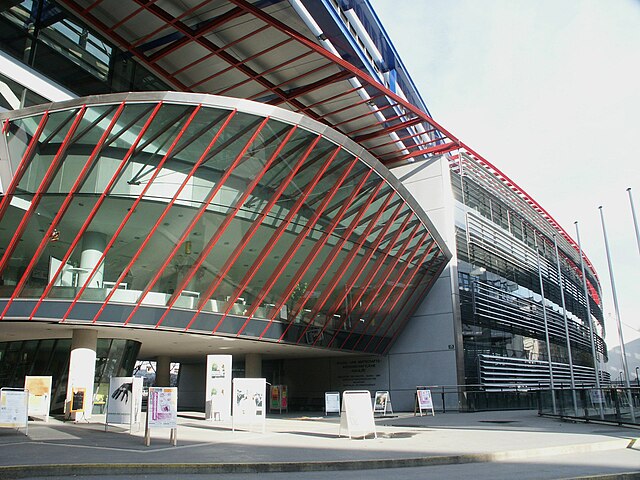Loading AI tools
Public university in Graz, Styria From Wikipedia, the free encyclopedia
The University of Graz (German: Universität Graz; old: Karl-Franzens-Universität Graz) is a public research university located in Graz, Austria. It is the largest and oldest university in Styria, as well as the second-largest and second-oldest university in Austria. The university is associated with numerous Nobel prize laureates and is highly regarded.
Universität Graz | |
 | |
| Latin: Carolo Franciscea Graecensis | |
| Type | Public |
|---|---|
| Established | 1585 |
Academic affiliations | Coimbra Group, Utrecht Network |
| Endowment | €230,7 million |
| Rector | Peter Riedler |
Academic staff | 3,292[1] |
Administrative staff | 1,439[1] |
| Students | 30,000[1] |
| Location | , , Austria 47°04′41″N 15°26′57″E |
| Campus | Urban |
| Nobel Laureates | 6 |
| Website | uni-graz.at |
 | |

The university was founded in 1585 by Archduke Charles II of Austria. The bull of 1 January 1586, published on 15 April 1586, was approved by Pope Sixtus V.[2] For most of its existence it was controlled by the Catholic Church, and was closed in 1782 by Emperor Joseph II in an attempt to gain state control over educational institutions. Joseph II transformed it into a lyceum, where civil servants and medical personnel were trained. In 1827 it was re-instituted as a university by Emperor Francis I, thus gaining the name Karl-Franzens-Universität, meaning Charles Francis University. About 30,000 students are currently enrolled at the university.
The university is divided into six faculties, the two largest are the Faculty of Arts and Humanities and the Faculty of Natural Sciences. The other faculties are the Faculty of Law; the Faculty of Business, Economic and Social sciences; the Faculty of Environmental, Regional and Educational Sciences; and the Faculty of Catholic Theology. The Faculty of Medicine was separated from the university by state legislation in 2004 and became an independent university – the Medical University of Graz. The faculties offer a wide range of undergraduate (BA, BSc), graduate (MA, MSc), and doctoral degree (PhD) programmes, as well as special teaching degrees in their specific areas of expertise.
Since its re-installation, the university has been home to many internationally renowned scientists and thinkers. Ludwig Boltzmann was professor at the university twice, first from 1869 to 1873 and then from 1876 to 1890, while he was developing his statistical theory of heat. Nobel laureate Otto Loewi taught at the university from 1909 until 1938 and Victor Franz Hess (Nobel prize 1936) graduated in Graz and taught there from 1920 to 1931 and from 1937 to 1938. The physicist Erwin Schrödinger briefly was chancellor of the university in 1936.
The University of Graz does not have a distinct faculty of engineering, however, Graz University of Technology, which is focused on engineering and technology, offers inter-university undergraduate and postgraduate programmes in cooperation with the university's Faculty of Natural Sciences under the name "NAWI Graz". The main intention behind the cooperation was to avoid duplication of efforts and infrastructure, especially in cost-intensive subjects such as chemistry, industrial chemistry, physics, and geosciences, as both universities are located in close proximity to each other. Students enrolled in one of these programmes attend lectures and seminars at both universities and are awarded a combined degree at the end of their studies. Along with the NAWI collaboration, the university is cooperating with the TU Graz to combine their two physics institutes into one, the Graz Center of Physics. The project is planned to be finished in 2030 and located on the campus of the University of Graz instead of the former Vorklinik.[3]
Since Graz was the capital of the then multiethnic Duchy of Styria, Slovenes from Lower Styria came there to study. It has served as a gateway to South-East Europe for Austrian scholars, scientists and businesses. The establishment of the Department for Slovene Language and Literature at the University of Graz, for example, laid the foundation for scholarly studies of Slovenian culture, literature, and language bundled in the so-called Slovene studies.[4]

The university has 6 faculties. Each of the 6 faculties is in turn divided into institutes and centers:[5]

In addition to the institutes and centers of the 6 faculties, there are other university and cross-faculty service areas:[6]
The university ranks highest in Arts and Humanities, coming 287th in the 2018 QS World University Rankings, whereas all other subject areas lag behind, with the Faculty of Social Sciences ranking at 451–500 and the Faculty of Natural Sciences ranking at 401–450.[12]
Historically speaking, for most of its existence the University of Graz was controlled by the Catholic Church. Even after its re-installation in 1827, it took until 1848 for the university's basic principles to be readjusted in accordance with the ideals of Wilhelm von Humboldt and the Enlightenment, meaning that the university became autonomous from the state as well as from the church and their influence as far as possible.[13]
The Faculty of Catholic Theology has been retained as a part of the university ever since it was established, however, its importance in terms of number of students and its influence on the university board have been diminishing. Evidently, relations between the Catholic Church, especially the local bishop, and the university's Faculty of Theology remain strong, yet general policy is not influenced by these connections. To demonstrate the university's independence and its shift of focus, the Christogram IHS on the very top of the university's seal has been replaced with the sun, symbolising the Enlightenment and von Humboldt's ideas.[14]

Seamless Wikipedia browsing. On steroids.
Every time you click a link to Wikipedia, Wiktionary or Wikiquote in your browser's search results, it will show the modern Wikiwand interface.
Wikiwand extension is a five stars, simple, with minimum permission required to keep your browsing private, safe and transparent.